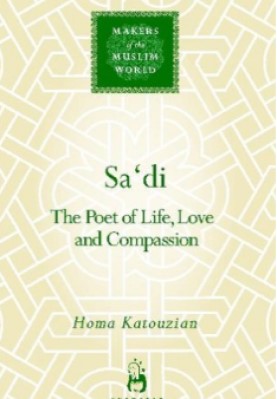
| Sadi The Poet Of Life Love And Compassion |
| Homa Katouzian |
| 169 |
| |
| PDF Direct Download Link |
| Click for Hard Copy from Amazon |
Sa’di The Poet of Life Love and Compassion – Book Sample
CONTENTS – Sa’di The Poet of Life Love and Compassion
- PREFACE ix
- SA‘DI, THE CLASSICS AND THE MODERNS 1
- LIFE AND WORKS 9
- Birth and Death 10
- Sa‘di’s Poetical Signature 12
- Sa‘di’s Travels 13 Escape from School? 17 Sa‘di’s Debates? 18 Sa‘di and the Courts 22 Works 25
- SONGS OF LOVE AND ODES TO BEAUTY 35
- The Evolution of Poetry 36 Sa‘di, Hafiz, Rumi 38 Women andYouths 42 Ghazals on Human Love 50
- 4 REALITY AND APPEARANCE: MYSTICISM AND LOGIC 71
- Received Opinions 71
- Sufism in Sa‘di’s Time 74
- Conclusion on Sa‘di and Sufism 87
- 5 TEACHING MANNERS AND MORALS 89
- Education and Edification 91
- Morals 94
- 6 THE WAYS OF SHAHS AND VIZIERS 117
- Shahs 119
- The Transience of Power and Existence 123
- Ideal Government 125
- Other-worldliness 129
- Viziers 135
- CONCLUDING REMARKS 143
- Endnotes 147
- Selected Bibliography 151
- Index 155
SA‘DI, THE CLASSICS AND THE MODERNS
Sa‘di is a poet and writer of the seventh century hijra, the thirteenth century of the Christian era, and is one of the greatest classical Persian writers both in prose and poetry.
Until the 1940s his Golestan was taught to school children as a model of perfect prose, and his Bustan was regarded as a guidebook to a moral and virtuous life, much as Aristotle’s Ethics was regarded in Victorian England.
However, not unlike Iranian views in other fields, opinion changed abruptly and drastically in the second half of the twentieth century. Sa‘di went out of fashion, and his cult of worship was replaced even more strongly by that of Hafiz. As Jean-Jacques Rousseau might have asked, “How did this change come about?”
Sa‘di’s impact on later poets and writers has been very great, and certainly until the early twentieth century he was universally regarded as the greatest Persian poet of all time. Sa‘di and, following him, Hafiz are among the leading stars in the old classical traditions of Persian poetry which began in the tenth and ended in the fifteenth century. From then until the late eighteenth century various new genres and styles emerged, which reached their peak in the so-called Indian style of poetry.
This new style, with its emphasis on complex images and metaphors, was refreshing at first and pro- duced at least one outstanding poet comparable to the old classics, i.e. Sa’eb Tabrizi, but time was not on its side. It also suffered from a relative lack of patronage from the ruling Safavid dynasty.
Therefore, by the end of the eighteenth century this new style of literature had declined to a level not previously experienced in Persian poetry.
This led to a reversion to the old classical styles, a movement which became known as “the literary restoration” and launched the neo- classical styles of the nineteenth century. In this new wave of Persian literature Sa‘di cast a long and wide shadow, and virtually all of his works were imitated more or less successfully by poets and writers of the Restoration.
Thus, in the nineteenth century, Sa‘di came to be regarded as the leading Persian poet of all time and the greatest hero of Persian literature. In a footnote to his Hajji Baba of Isfahan, written in the early nineteenth century, James Morier described Sa‘di as “Persia’s national poet.” Morier was neither a literary critic nor a scholar of Persian literature, and this description undoubtedly reflects what he had heard about Sa‘di in Iran.
Of the other classical poets, Hafiz was also greatly admired, and his followers enjoyed reading his poetry while trying to find answers to questions which they would formulate before even opening his book of lyrics, what in Persian is described as fal-e Hafiz and is still as popular as ever. Rumi was often described as Molla-ye Rum, and was more admired for being a Sufi star than a great poet.
It is not surprising, therefore, that readings from his works were largely based on his Mathnavi-ye Ma‘navi rather than his voluminous divan of lyrics which, although still mystical, are of the highest quality as pure poetry. Ferdowsi was popular for the myths and legends of his Shahnameh, which were often recited by the local reciting masters, or naqqals, in public places, although he was not normally put at the same level as the first three.
Nezami Ganjavi was sometimes added to this list of poets, so that some nineteenth- and twentieth-century classical scholars put him next to Ferdowsi as the fifth member of the galaxy of stars of classical Persian poetry. Khayyam was virtually unknown until his translation by Fitzgerald made him famous in the West and also, in time, in Iran.
There was, therefore, no disagreement about the Big Three leading classical poets, while many of the literati added Ferdowsi to make the Big Four, and some included Nezami in the Big Five.
To read more about the Sadi The Poet Of Life Love And Compassion book Click the download button below to get it for free
Report broken link
Support this Website
for websites
Sa’di: The Poet of Life, Love and Compassion